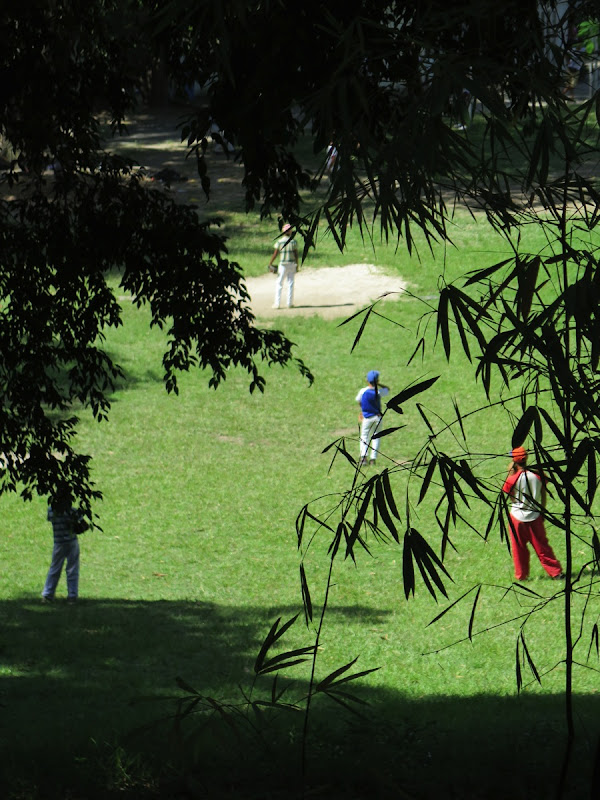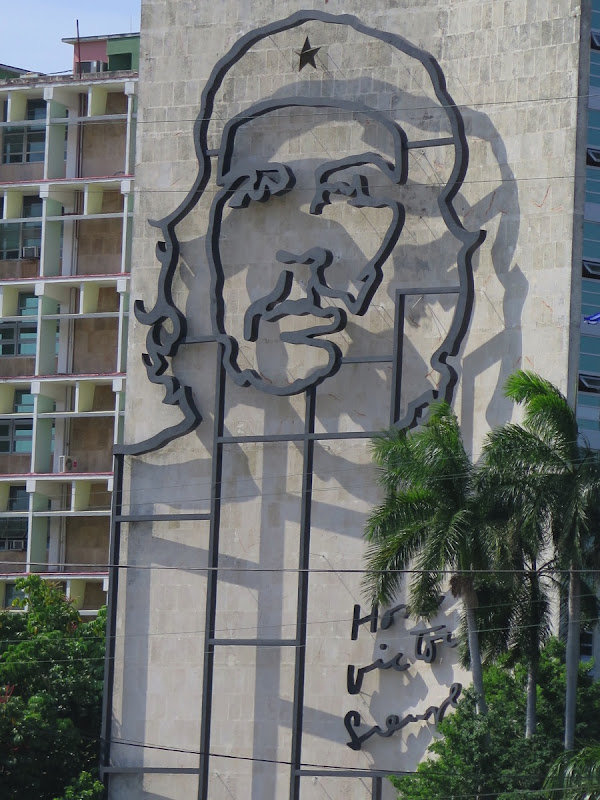
We spent the day out of Havana, and even the drive out was interesting. We drove through Miramar which is a wealthy suburb near the ocean founded after 1929. It has large and beautiful homes, many that are still in good repair. Many were left behind by families that left Cuba after 1959, some in the keeping of the house staff or family that stayed. Other homes were abandoned and the state reallocated them to people in need or people who had fought with Fidel. It is the area of Havana that houses diplomats, the president, and "other important people."
There are no mortgages in Cuba. People live in houses that were in their family for a long time and only recently (2011) did they have the right to sell or buy a home. These transactions of buying and selling a house privately are done in cash. People who are in great need, say a single mother, will be given a place to live by the state. Other people are allocated housing based on a job position. Some people can also "rent to own," a house or apartment. While banks give loans, they are not mortgages and Cubans do not like debt, because, our tour guide explained, "Who knows what tomorrow will bring." Many people live in a state allotted home or apartment for no rent at all, and only pay for electricity and water.
Driving through the city there are some building that look in decent repair, some in really good shape (the boutique hotels in Old Havana are an example) and others that are literally crumbling. The three types are all mixed together.
 |
| Our guide at Las Terrazas |
Our main destination today was something like a commune...or a kibbutz... neither term used by our guides. Called La Terrazas, it is a community in a mountainous, forested area to the west of Havana. Its founder convinced people to join him in making a model community for reforestation and agriculture. It is also a protected world biosphere. The name comes from "terrace" which is how erosion is prevented when crops are grown in mountainous areas (now and in the past)-- horizontal bands every few meters, up and down the inclines. Today there are 1,020 inhabitants of the community and they farm coffee, twenty species of native tree, and four economically important timber species that are not native (teak, mahogany, pine and eucalyptus).
 |
| Summer daycare |
The community has a school serving 290 students, a lake, a zipline, a coffee shop with a barista (we had some awesome cold coffee sort of like a Frappucino), and some artisans, a day care, a medical clinic, and its own ration store. We saw all.
 |
| The ration store |
 |
| Picking up a bread ration |
The ration system is particularly Cuban. Every citizen has a ration card with a monthly allotment of staples: rice, beans, cooking oil, charcoal, sugar, matches, 1/4 of a chicken and bread were examples. The amount of food is paid for, but for the whole allotment, a person might pay only a few pesos. This amount of food is not enough to cover a month of eating-- and generally is thought of as being ok for the first half of the month. Another reason why the food can be stretched so far, is that workers and school children are given a big lunch during the day. So, breakfast and dinner are the two meals that must be eaten at home. There has been talk of discontinuing the system, but it is very popular. The minimum wage salary is twenty pesos a month, and a professional like a physician makes about forty pesos, so the greatly subsidized food makes a big difference.
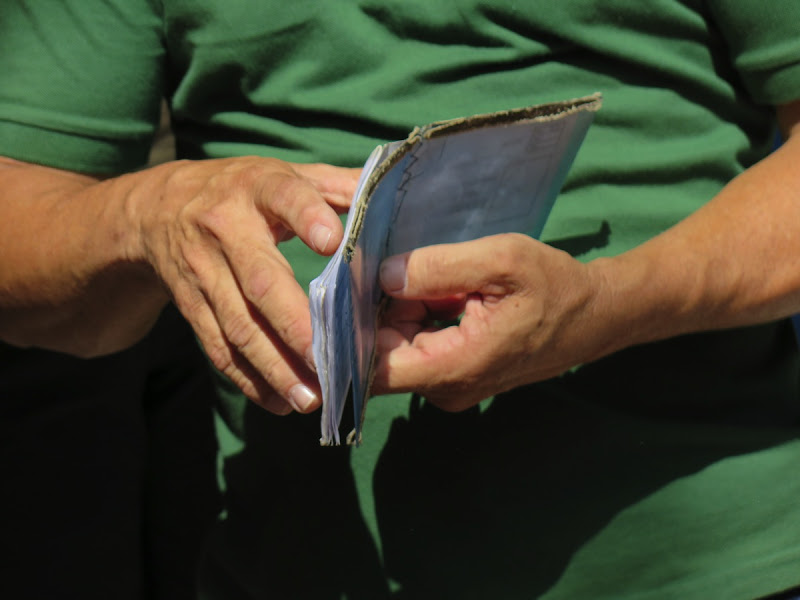 |
| Ration book |
 |
| The board displays the selection in the ration store. |
The clinic was small and very accessible. We met the two doctors, both young women who were completing their two years of social service. Medical school is six years long and students are finished when they are 22. After the two years of social service, they do one year of training in internal medicine, and then might begin a speciality or practice in a city. As doctors in the country they knew their patients very well; the patient files were contained in what were a sort of composition book of notes.
 |
| The bed in the medical clinic. |
Maternity care is very careful for those in the country, with home visits and clinic visits up to the 37th week of pregnancy where upon the mothers check in to a maternity hospital until delivery. Post-partnum visits are also mandatory and monitored. Not surprisingly, Cuba has one of the lowest infant mortality rates in the world, and it is lower than the rate in the USA.
The youth of the physicians was quite surprising, but most of their work is likely to be what a nurse practitioner would do. If an illness is at all serious, they call for an ambulance to take the patient to the city. Similarly, if a patent needs a specialist, the physician will call and make the appointment. The admirable part of the system is that the people in the community are really known by the doctors. In fact, when housing is determined by the leaders of the community, one of the doctors sits in on the decisions because they understand the needs of the people so well.
We had a short stop at the studio of the artist Lester Campo. His work is in museums all over the world and he studied in the states as a young man. His art interprets nature with symbolism, and love, and in pieces, decay. He has an idyllic spot by the lake at Las Terrazas because the property belonged to his father before the community was organized. We were especially taken by a print on canvas of a Ceba tree and it will come home with us.
 |
| Eating lunch family style at Las Terrazas; this was our only meal at a state run paladar. |
We ate at in the community, in the open air, and this was the most traditional meal we've had so far, and the only state run restaurant on our itinerary. The kitchen is run by a grandmother of many and I am very happy that I have never had to cook in 90 degrees and 97% humidity in a kitchen like hers.
 |
| Paladar chef |
The bus became very quiet as we made our way to our afternoon stop at Fusterville. Fuster is an artist who is alternatively know as the "Picasso" or the "Gaudi" of Cuba. The first thing one notices is the mosaics that cover absolutely every surface of his home and increasingly around his neighborhood. Fuster is also a painter and many of his images are cubist like Picasso. He is also an art teacher and gives lessons to children. The area "dazzles" the eye.

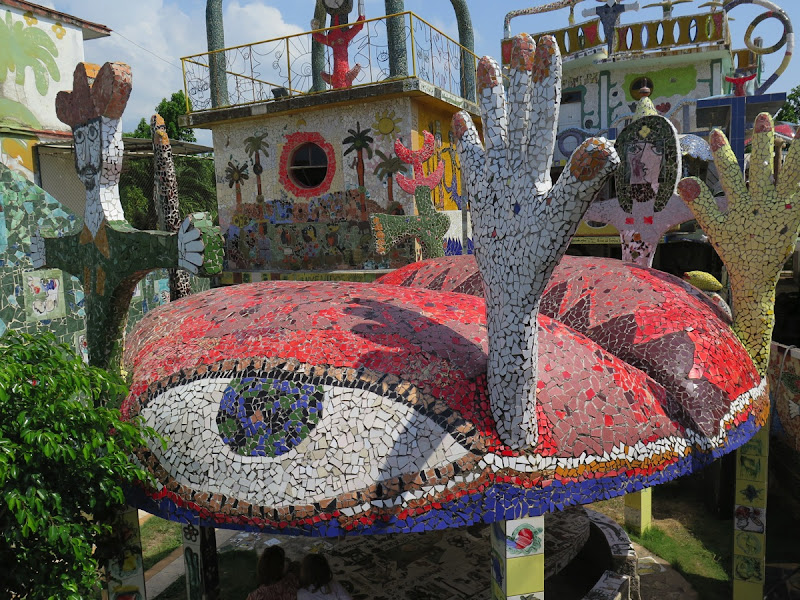

Tonight was our night "on our own," to eat at a paladar of choice. We arranged to hire a vintage car with new friends and drive around the city for about an hour before our dinner reservation. Yes, a Belaire! Yes, it was pink, and a convertible. These cars are actually out of my memory range, although something about the steering wheel and upholstery rang bells. Being in a convertible was very much more pleasant then being closed up would have been-- these cars burn oil...
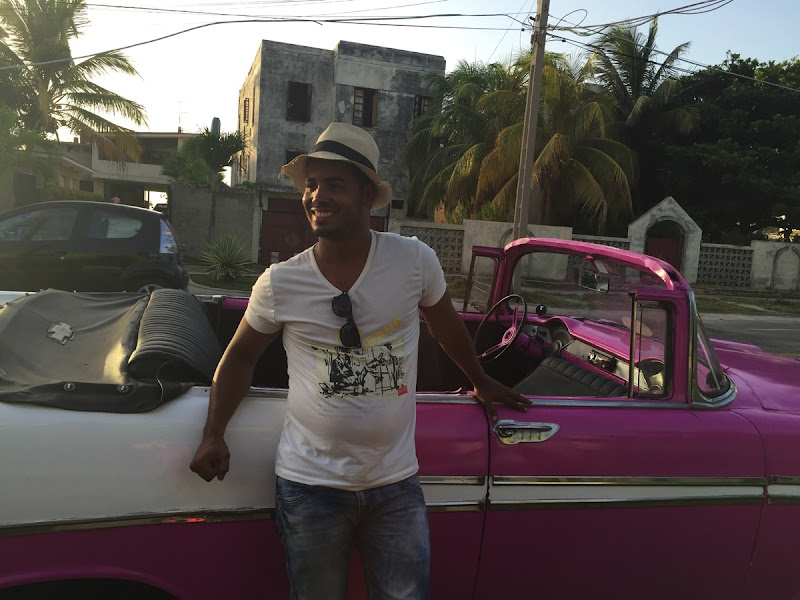
Our driver learned English on the street and was cheerful and garrulous while also being careful and evasive in his answers.


There was nothing about the paladar that made me think I was in Cuba. We ate at Vistamar, in Miramar where our morning exhibition had routed us in the morning, The illusion pool, the furniture, the high terrace dining and the seafood on the menu were all indicative of a classy restaurant in Malibu or Miami.





















